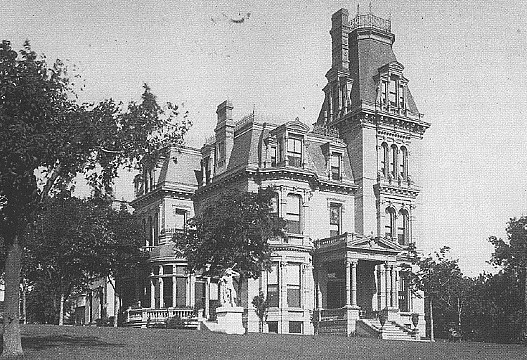Norman Kittson House
201 Summit Avenue, St. Paul, Minnesota
Completed in 1884, for "Commodore" Norman Wolfred Kittson (1814-1888) on the corner of Summit and Selby Avenue, St. Paul. The towered French Second Empire mansion surrounded by tall elms was designed by local architect Abraham Radcliffe (1827-1886). It was torn down to make way for the Cathedral of Saint Paul that stands in its place today. It is one of the 60 lost mansions of Minnesota....

This house is best associated with...
Norman Kittson - for whom Kittson County, Minnesota, is named - was Mayor of St. Paul and a railroad baron intricately linked through business with his better remembered friend and neighbour James J. Hill. One of America's early millionaires, Kittson was the owner of some of the finest thoroughbred racehorses in the country. Near to his mansion in St. Paul he constructed "Kittsondale," a vast horse-racing track with a 64-stall stables. He also owned Erdenheim Farm, a famous stock farm that was later acquired by no less than George Dunton Widener, Jr. (1889-1971), of the famed Lynnewood Hall near Philadelphia.
In 1875, Kittson purchased the site for his mansion from Mrs Stella (Humphrey) Selby (1824-1893), the widow of Jeremiah for whom Selby Avenue is named. It was bound by Dayton Avenue to the north, Selby Avenue to the south, and because it lay directly on the road that led into St. Paul - to accommodate those who were used to taking the road - Kittson left the front and back gates to his estate open as a public thoroughfare.
His typically Victorian mansion featured a French mansard roof and scroll-saw trim. Before the construction of James J. Hill House, it was the most opulent private home in the State of Minnesota. But, Kittson died only four years after it was completed - ironically on one of his railroad cars shortly after ordering dinner.
His typically Victorian mansion featured a French mansard roof and scroll-saw trim. Before the construction of James J. Hill House, it was the most opulent private home in the State of Minnesota. But, Kittson died only four years after it was completed - ironically on one of his railroad cars shortly after ordering dinner.
After his death, the mansion became a "less than first-class" boarding house. In 1904, agents acting on behalf of Archbishop John Ireland (1838-1918) purchased the mansion for $52,000 and it was torn down a year later to make way for the Catholic Cathedral of Saint Paul that stands in its place today. Some of the original features of the house, such as the stained-glass windows, elegant marble fireplaces and crystal chandeliers, were salvaged before its demolition and refitted at the Wright-Prendergast House, also in St. Paul.
You May Also Like...
Categories
Styles
Share
Connections
Be the first to connect to this house. Connect to record your link to this house. or just to show you love it! Connect to Norman Kittson House →







